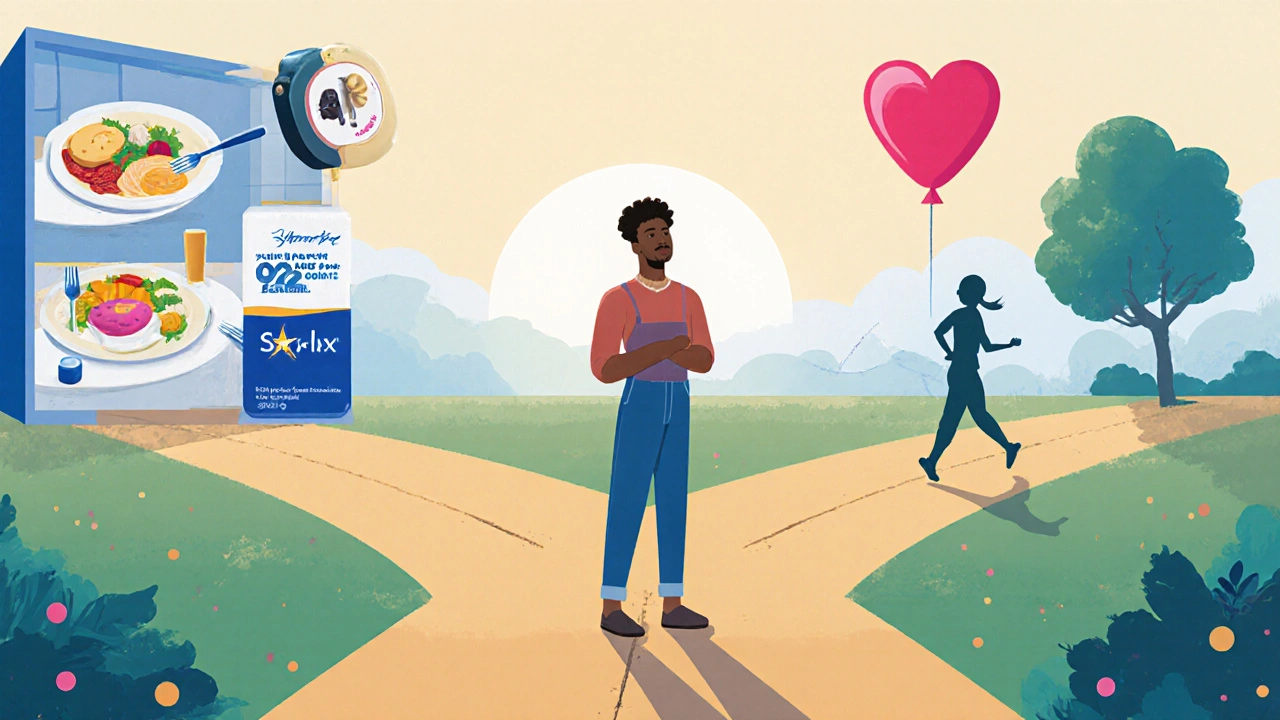5 Oct 2025
- 19 Comments
Starlix vs Alternatives: Diabetes Drug Comparison Tool
Class: Meglitinide
Onset: 15-30 min
Duration: 4-6 hours
Typical Dose: 60-120 mg before meals
HbA1c ↓: 0.5-0.8%
Class: Biguanide
Onset: 1-2 hours
Duration: 24 hours
Typical Dose: 500-2000 mg BID
HbA1c ↓: 0.8-1.2%
Class: Meglitinide
Onset: 15-30 min
Duration: 6-8 hours
Typical Dose: 0.5-2 mg before meals
HbA1c ↓: 0.6-0.9%
Class: Sulfonylurea
Onset: 30-60 min
Duration: 12-24 hours
Typical Dose: 2.5-10 mg daily
HbA1c ↓: 0.6-1.0%
Class: DPP-4 Inhibitor
Onset: 1-2 hours
Duration: 24 hours
Typical Dose: 100 mg daily
HbA1c ↓: 0.5-0.7%
| Drug (Generic) | Class | Onset | Duration | Typical Dose | HbA1c ↓ | Weight Effect | Hypoglycemia Risk | UK Cost/Month |
|---|---|---|---|---|---|---|---|---|
| Nateglinide | Meglitinide | 15-30 min | 4-6 h | 60-120 mg before meals | 0.5-0.8% | Neutral | Low (if taken with food) | £12-£18 |
| Repaglinide | Meglitinide | 15-30 min | 6-8 h | 0.5-2 mg before meals | 0.6-0.9% | Neutral | Low-moderate | £15-£22 |
| Metformin | Biguanide | 1-2 h | 24 h | 500-2000 mg BID | 0.8-1.2% | Weight-neutral or slight loss | Very low | £3-£6 |
| Glipizide | Sulfonylurea | 30-60 min | 12-24 h | 2.5-10 mg daily | 0.6-1.0% | Neutral | Moderate-high | £5-£9 |
| Sitagliptin | DPP-4 Inhibitor | 1-2 h | 24 h | 100 mg daily | 0.5-0.7% | Neutral | Very low | £30-£35 |
| Empagliflozin | SGLT2 Inhibitor | 1-2 h | 24 h | 10-25 mg daily | 0.5-0.8% | Loss 1-3 kg | Low (except dehydration) | £45-£55 |
- + Rapid onset, ideal for post-meal control
- + Low hypoglycemia risk when taken with food
- + Affordable generic option
- - Requires meal timing; not suitable for irregular schedules
- - Limited long-term data compared to metformin
- + First-line therapy with strong evidence
- + Weight-neutral or slight weight loss
- + Very low hypoglycemia risk
- - May cause GI upset in some patients
- - Not suitable for those with kidney issues
When a doctor prescribes an oral agent for type 2 diabetes, the choice can feel like a maze of brand names, mechanisms, and side‑effect profiles. Starlix (generic name Nateglinide is a short‑acting meglitinide that stimulates insulin release after meals). This article breaks down how Starlix stacks up against the most common alternatives, so you can see which pill fits your lifestyle, health goals, and budget.
What is Starlix (Nateglinide)?
Starlix belongs to the meglitinide class of oral hypoglycemics. It targets the pancreatic beta‑cells, prompting a rapid insulin burst that curbs post‑meal glucose spikes. Because its action peaks within 30‑60 minutes and fades after 4‑6 hours, dosing aligns with main meals - typically one tablet before breakfast and another before dinner.
Key attributes:
- Onset: 15‑30 minutes
- Peak effect: 1‑2 hours
- Duration: 4‑6 hours
- Typical dose: 60-120mg before meals
- HbA1c reduction: ~0.5-0.8% in clinical trials
- Hypoglycemia risk: low when meals are not skipped, higher if taken without food
How does Starlix differ from other oral diabetes drugs?
The landscape of oral agents includes big‑uanides, sulfonylureas, DPP‑4 inhibitors, SGLT2 inhibitors, and other meglitinides. Each class attacks blood sugar from a different angle. Starlix’s rapid, meal‑time action makes it ideal for people who need precise control after eating but don’t want a drug that works all day.
In contrast, drugs like metformin act continuously to lower hepatic glucose production, while sulfonylureas provide a longer, less flexible insulin push. Newer agents such as sitagliptin (a DPP‑4 inhibitor) and empagliflozin (an SGLT2 inhibitor) work independent of meals, offering steady glucose lowering and additional benefits like weight loss or cardiovascular protection.

Top alternatives to Starlix
Below are the most widely used oral options you’ll encounter in the UK.
Repaglinide
Repaglinide is the other meglitinide on the market. Its pharmacokinetic profile mirrors Nateglinide but with a slightly longer duration (6‑8hours). It’s useful if you have a later dinner or need flexibility for a third meal.
Metformin
Metformin is a big‑uanide that reduces liver glucose output and improves peripheral insulin sensitivity. It’s the first‑line therapy for most UK patients because it’s cheap, weight‑neutral, and has a robust safety record.
Glipizide (Sulfonylurea)
Glipizide belongs to the sulfonylurea class and provides a longer‑lasting insulin release that can cover two or three meals per day. It’s potent but carries a higher hypoglycemia risk, especially in older adults.
Sitagliptin (DPP‑4 inhibitor)
Sitagliptin inhibits the enzyme DPP‑4, prolonging the action of incretin hormones that boost insulin after meals. It offers modest HbA1c reductions (0.5‑0.7%) with minimal hypoglycemia, but costs more than generic options.
Empagliflozin (SGLT2 inhibitor)
Empagliflozin blocks renal glucose reabsorption, causing excess glucose to be excreted in urine. It delivers steady glucose lowering, modest weight loss, and proven heart‑failure benefits, albeit with a higher price tag and a risk of genital infections.
Comparison table
| Drug (generic) | Class | Onset | Duration | Typical Dose | HbA1c ↓ (≈) | Weight effect | Hypoglycemia risk | UK cost/month (approx.) |
|---|---|---|---|---|---|---|---|---|
| Nateglinide | Meglitinide | 15‑30min | 4‑6h | 60‑120mg before meals | 0.5‑0.8% | Neutral | Low (if taken with food) | £12‑£18 |
| Repaglinide | Meglitinide | 15‑30min | 6‑8h | 0.5‑2mg before meals | 0.6‑0.9% | Neutral | Low‑moderate | £15‑£22 |
| Metformin | Biguanide | 1‑2h | 24h | 500‑2000mg BID | 0.8‑1.2% | Weight‑neutral or slight loss | Very low | £3‑£6 |
| Glipizide | Sulfonylurea | 30‑60min | 12‑24h | 2.5‑10mg daily | 0.6‑1.0% | Neutral | Moderate‑high | £5‑£9 |
| Sitagliptin | DPP‑4 inhibitor | 1‑2h | 24h | 100mg daily | 0.5‑0.7% | Neutral | Very low | £30‑£35 |
| Empagliflozin | SGLT2 inhibitor | 1‑2h | 24h | 10‑25mg daily | 0.5‑0.8% | Loss 1‑3kg | Low (except dehydration) | £45‑£55 |

Who should consider Starlix versus the alternatives?
Starlix (Nateglinide) shines for:
- Patients with irregular meal patterns who need a drug that can be skipped without losing overall control.
- Individuals who have tried metformin but experience gastrointestinal upset.
- Those who prefer a cheap, generic option that still offers post‑prandial coverage.
Best suited not for:
- Elderly patients with inconsistent eating habits - the hypoglycemia risk rises if a dose is taken without food.
- People who need cardiovascular or renal protection; SGLT2 inhibitors like empagliflozin add proven heart‑failure benefits.
Repaglinide is a good backup when dinner is late or a third dose is required.
Metformin remains the go‑to first line for most, thanks to its low cost, weight‑loss potential, and strong evidence for reducing long‑term complications.
Glipizide works if you need a once‑daily dose and can tolerate a slightly higher hypoglycemia risk.
Sitagliptin fits patients on multiple meds who need a drug with minimal interaction and low hypoglycemia risk, accepting the higher price.
Empagliflozin is the choice for those with established heart disease, chronic kidney disease, or a desire to lose weight, provided they can manage the urinary side‑effects.
Practical tips for clinicians and patients
- Start low, go slow. For Nateglinide, a 60mg dose before the largest meal lets you gauge tolerance.
- Always pair a meglitinide with a carbohydrate‑containing snack. Skipping food after a dose is the fastest way to get low blood sugar.
- Monitor HbA1c after 12weeks. If reduction is less than 0.5%, consider adding metformin or switching to a longer‑acting agent.
- Check kidney function before prescribing SGLT2 inhibitors; they’re contraindicated if eGFR<30mL/min/1.73m².
- Review cost with patients. A £15‑month generic pill may be more sustainable than a £35‑month DPP‑4 inhibitor, especially under NHS pre‑approval.
- Educate patients on signs of hypoglycemia - shakiness, sweating, confusion - and how to treat it quickly with 15g of fast‑acting carbohydrate.
Frequently Asked Questions
Can I take Starlix and Metformin together?
Yes. Combining a meglitinide with metformin is common practice. Metformin tackles basal glucose production while Starlix controls post‑meal spikes. Start Metformin at a low dose (500mg) to avoid GI upset, then add Starlix as needed.
How does the hypoglycemia risk of Nateglinide compare to Sulfonylureas?
Nateglinide’s short action means the risk drops sharply once the meal is over. Sulfonylureas like glipizide stay active for up to 24hours, so they cause more prolonged low‑blood‑sugar episodes, especially in the elderly.
Is Starlix covered by the NHS?
Nateglinide is listed on the NHS drug tariff, so it is generally reimbursed when prescribed for type 2 diabetes. However, local prescribing policies may favor metformin first‑line, so discuss alternatives with your GP.
Can I switch from Repaglinide to Starlix without a wash‑out period?
Both drugs have similar half‑lives, so you can simply replace the Repaglinide dose with an equivalent Nateglinide dose (usually 60mg) at the next meal. Monitor glucose for a week to fine‑tune the amount.
Why might a doctor choose an SGLT2 inhibitor over Starlix?
SGLT2 inhibitors provide continuous glucose loss through urine, improve blood pressure, and reduce heart‑failure hospitalisations. For patients with cardiovascular disease or chronic kidney disease, those benefits outweigh the modest post‑meal control offered by Nateglinide.


Sebastian Samuel
October 5, 2025Listen up, you can't just pop Starlix and hope for miracles – you gotta pair it with a proper meal or you’ll be crashing hard! 😡💥
Mitchell Awisus
October 10, 2025Wow, the table is super handy, and the onset of Nateglinide (15‑30 min) really shines for post‑meal spikes; however, note that the duration (4‑6 h) means you’ll need to time it precisely, otherwise you risk under‑coverage; also, the cost (£12‑£18) is modest compared to SGLT2 inhibitors; finally, if you have kidney issues, Metformin might be safer.
Annette Smith
October 14, 2025Starlix works fast after meals and can be a good option if you don’t like big pills.
beth shell
October 19, 2025It’s worth considering for people who need short‑acting control.
khushali kothari
October 24, 2025From a pharmacodynamic perspective, Nateglinide’s rapid insulinotropic effect is mediated via ATP‑dependent K⁺ channel closure, resulting in a prompt depolarization of β‑cells; this mechanistic nuance distinguishes it from sulfonylureas, which exhibit a prolonged binding affinity, thereby increasing hypoglycemic propensity in inconsistent eating patterns.
Brandon Smith
October 28, 2025Prescribing Starlix without addressing lifestyle fundamentals is ethically negligent; the medical community must prioritize metformin as first‑line therapy due to its robust evidence base, cost‑effectiveness, and cardioprotective profile, rather than resorting to a drug that merely masks poor dietary habits.
darwin ambil
November 2, 2025Yo, if you’re skipping breakfast, ditch the Nateglinide – it’s not magic, it needs food! 😂
Kelvin Van der Maelen
November 7, 2025Honestly, the hype around Starlix is overblown; you’re better off with a tried‑and‑true sulfonylurea unless you love paying extra for a “quick fix”.
Joy Arnaiz
November 11, 2025Consultation with a qualified endocrinologist is indispensable before initiating any oral hypoglycemic regimen.
Christopher Eyer
November 16, 2025While many tout the safety of metformin, I find that its GI side effects are often underreported and can lead to poor adherence, making drugs like repaglinide a more tolerable option for some patients.
Mike Rosenstein
November 20, 2025It's important to balance efficacy with patient preferences; if a person values a low hypoglycemia risk and can adhere to meal timing, Starlix can be a reasonable addition to their regimen.
Ada Xie
November 23, 2025In accordance with established clinical guidelines, the selection of an oral antidiabetic agent should be individualized, taking into account comorbid conditions, cost considerations, and the pharmacokinetic profile of the drug.
Stephanie Cheney
November 25, 2025For anyone feeling overwhelmed by the options, start with Metformin; it’s widely studied, inexpensive, and generally well‑tolerated.
Georgia Kille
November 27, 2025👍 Metformin is a solid foundation, and you can layer a meglitinide later if post‑meal spikes persist.
Jeremy Schopper
November 30, 2025Indeed, the rapid onset of Nateglinide is advantageous for patients with irregular dining schedules; however, consistent meal patterns are still essential to avoid hypoglycemia!!!
liza kemala dewi
December 2, 2025When evaluating oral agents for type 2 diabetes, one must first acknowledge the heterogeneity of the patient population, as metabolic phenotypes differ markedly across individuals. The rapid pharmacodynamic onset of Nateglinide offers a distinct advantage for those who experience pronounced post‑prandial excursions, yet this benefit is contingent upon precise temporal coordination with meals. Moreover, the relatively short duration of action mitigates the risk of prolonged hypoglycemia, a common concern with longer‑acting sulfonylureas. In contrast, metformin exerts its primary effect on hepatic gluconeogenesis, providing a steady basal reduction in fasting glucose, which may be more suitable for patients with elevated fasting glucose levels. Cost considerations also play a pivotal role; while Starlix remains affordable in the UK, the cumulative expense of multiple agents can become prohibitive. Cardiovascular outcomes data further differentiate agents, as SGLT2 inhibitors have demonstrated robust reductions in major adverse cardiac events, an advantage not shared by meglitinides. Patient adherence is another critical factor; a drug requiring strict meal timing may prove challenging for individuals with unpredictable schedules or cognitive impairment. The side‑effect profile of each medication must be weighed; metformin’s gastrointestinal intolerance is well documented, whereas Nateglinide’s main adverse effect is hypoglycemia when taken without food. Renal function also influences drug selection, given that certain agents are contraindicated at lower eGFR thresholds. Additionally, the impact on body weight varies, with some agents promoting modest weight loss, an attractive feature for overweight patients. Healthcare provider familiarity and clinical experience with a particular drug can affect prescribing patterns, potentially biasing choice away from newer or less familiar options. Insurance coverage and formulary restrictions may limit access to specific medications, steering patients toward more readily reimbursed drugs. The presence of comorbidities such as heart failure further narrows the therapeutic window, often favoring SGLT2 inhibitors for their proven benefits. Lifestyle interventions remain the cornerstone of diabetes management, and pharmacotherapy should complement, not replace, dietary and exercise modifications. Finally, shared decision‑making empowers patients, ensuring that the chosen regimen aligns with their preferences, lifestyle, and clinical objectives.
Jay Jonas
December 4, 2025Yo man, i think nateglinide is kinda cool but if you miss a meal you gonna feel like you're on a rollercoaster lol.
Liam Warren
December 7, 2025Indeed, adherence to the dosing schedule is paramount; incorporating patient education on carbohydrate counting can mitigate the risk of inadvertent hypoglycemia when using rapid‑acting secretagogues.
Brian Koehler
December 9, 2025Absolutely-leveraging the synergistic potential of a basal agent like metformin alongside a prandial meglitinide can optimize glycemic control, reduce HbA1c further, and enhance overall quality of life!!!